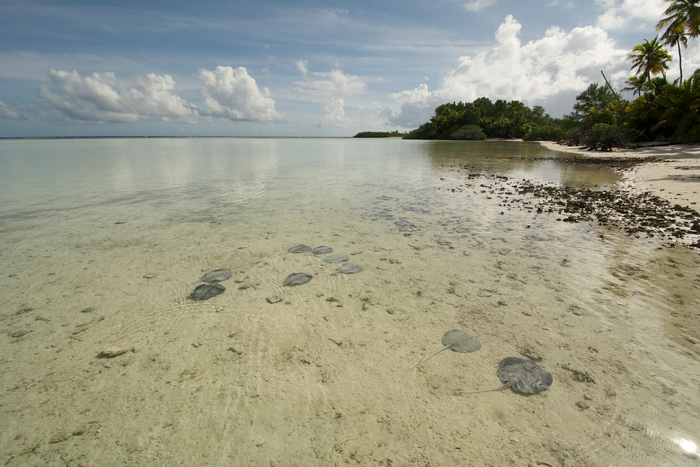Reviewed by Alex SmithApr 13 2022
Stingrays have had to overcome a number of challenges, primarily due to overfishing. Researchers from the Save Our Seas Foundation D’Arros Research Centre (SOSF-DRC) and the South African Institute for Aquatic Biodiversity have been trying to find out more regarding the lives of stingrays in Seychelles.
 Stingrays on the shallow sand flats of St Joseph Atoll. Image Credit: Rainer von Brandis | © Save Our Seas Foundation
Stingrays on the shallow sand flats of St Joseph Atoll. Image Credit: Rainer von Brandis | © Save Our Seas Foundation
Their office is the newly safeguarded D’Arros Island and St Joseph Atoll. Here, soft white sands result in shades of deep blue and turquoise. Beneath the waves, this pristine ecosystem is considered to be the residence of biodiverse coral reefs.
In a new study reported in the journal Frontiers in Marine Science, the researchers plunged into the significance of this altered habitat for susceptible stingrays. Sixty individuals from three species of stingray that reside in St Joseph Atoll year-round were monitored for a year on average. Environmental factors, like the temperatures and tides, were recorded during this time.
St Joseph Atoll is known to be the ideal place for such research. Comprising a deeper enclosed lagoon, a shallow uninterrupted reef flat, and two significant habitat types, it is a significant nursery area for the three study species: the porcupine whipray, the mangrove whipray and the cowtail stingray. Sea-grass beds, that are dispersed over the reef flats, are at times exposed and sometimes covered by water.
A method known as passive acoustic telemetry was utilized by scientists to follow the movements of stingrays. Around 20 stingrays were tagged from each species along with acoustic transmitters. Around 40 underwater tracking stations were distributed throughout the lagoon and reef-flat habitats. These stations tend to pick up the special sound pulses that have been emitted by each transmitter.
They discovered that stingrays prefer the shallow’s safety. However, environmental extremes like very low tides or specifically high or low water temperatures drive these rays into deeper waters, where they are subjected to threats from bigger and predatory sharks. The conditions here tend to be highly stable, but, it is also likely that their favored habitat will alter as the climate changes and extremes become a more regular occurrence.
The changes that happened have been noticed at D’Arros Island and St Joseph Atoll. Following severe coral bleaching that happened throughout the Western Indian Ocean, these flexible reefs are displaying signs of recovery.
For marine life, the Seychellois celebrate sanctuaries. In March 2020, via the Seychelles Marine Spatial Plan initiative, the government designated the waters encircling D’Arros Island and St Joseph Atoll as zone 1 and zone 2 equivalent marine protected areas.
This safety identifies the significance of D’Arros and St Joseph for threatened species and the wider ecosystem, which Chantel Elston, the paper’s lead author, and an SOSF project leader, has experienced firsthand.
Stingrays are really important for keeping oceans healthy, especially in tropical places like Seychelles. This research helps to present further evidence that the isolated St Joseph Atoll provides suitable habitat for threatened stingrays and that the newly announced marine protected area will have real conservation benefits.
Chantel Elston, Study Lead Author and Project Leader, Save Our SEAS Foundation
Studies like this help to protect vulnerable groups like stingrays more effectively. As Helena Sims, SOSF Seychelles Ambassador, explains, “When you know what the priority habitats for vulnerable species are and how and when they move around, management plans can be developed for their conservation.”
Also, when marine management is concerned, the Seychellois are ahead of the game. This last batch of marine protected area designations implies that 30% of Seychelles’ waters are currently protected, a decade ahead of the international target.
That the people of Seychelles are endowed with a pristine environment is not debated. In fact, the right to live in a healthy environment and the duty of citizens to protect, preserve and improve the environment and its cultural heritage are embodied in the Republic’s constitution.
Helena Sims, Seychelles Ambassador, Save Our SEAS Foundation
There is a very powerful conservation ethic, with the government concentrated on making ecological investments for the next generations.
The beauty of the nation has captured the heart of the Save Our Seas Foundation’s Founder, Abdulmohsen Abdulmalik Al-Sheikh.
I am constantly amazed by the abundant natural wonder in Seychelles and what this new research has revealed about the behavior of rays at D’Arros is no exception. Their intricate lives are fascinating and highlight the importance of sites like St Joseph for safeguarding the natural heritage of Seychelles.
Abdulmohsen Abdulmalik Al-Sheikh, Founder, Save Our Seas Foundation
Since 2004 the SOSF-DRC has been on a mission to conserve and display the ecological integrity of D’Arros Island and St Joseph Atoll through research, tracking, restoration and education.
Journal Reference:
Elston, C., et al. (2022) Stingray Habitat Use Is Dynamically Influenced by Temperature and Tides. Frontiers in Marine Science. doi.org/10.3389/fmars.2021.754404.